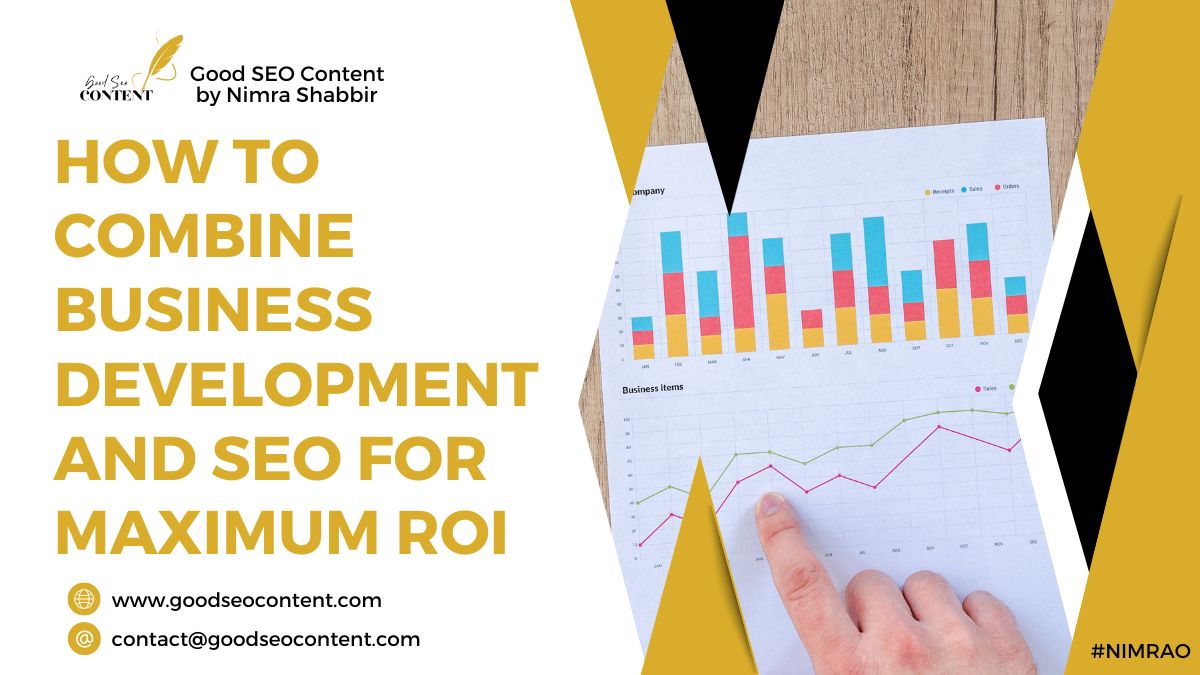In the fast-paced digital world, integrating Business Development and SEO strategies can significantly boost your company’s growth and profitability. When aligned, these two powerful strategies not only enhance visibility but also drive substantial revenue. This article will delve into how to effectively combine SEO and Business Development to maximize your return on investment (ROI).
Table of Contents
The Synergy Between Business Development and SEO
Business Development and SEO serve as the backbone for sustainable growth in any organization. Business development focuses on identifying new opportunities, forming strategic partnerships, and expanding the market reach. SEO, on the other hand, ensures that your business is visible to potential clients by improving your search engine rankings.
When these two strategies are combined, they create a robust growth engine. Business development identifies growth opportunities, while SEO ensures that your company is visible online when potential clients search for related products or services. This combination leads to increased traffic, better lead generation, and ultimately, higher revenue.

Read: Maximizing ROI in 2042: Aliging SEO and Business Development
Key Benefits of Integrating SEO with Business Development
- Enhanced Online Presence: With a well-optimized SEO strategy, your business is more likely to appear at the top of search engine results, making it easier for potential clients to find you.
- Improved Lead Generation: SEO drives organic traffic to your site, which can be converted into leads through content tailored to address the needs identified by your business development efforts.
- Cost-Efficient Growth: Investing in SEO is a cost-effective way to ensure long-term growth, particularly when aligned with business development goals.
- Informed Decision Making: Both SEO and business development rely on data. Combining them allows for more comprehensive insights into market trends, customer behavior, and competitive analysis.
Strategies for Combining SEO and Business Development for Maximum ROI
1. Align SEO with Business Development Objectives
The first step in combining SEO and Business Development is to ensure that your SEO strategy aligns with your business development goals. For example, if your business development team is focusing on entering a new market, your SEO strategy should target keywords and create content that appeals to that specific market.
Example: If your business is expanding into a new geographical area, optimize your content for local SEO by incorporating region-specific keywords and creating dedicated landing pages.

Read: Story Telling in Business Development
2. Enhance Partnerships with Business Development and SEO
Strategic partnerships are a key element of business development. SEO can support these partnerships by co-creating content, such as blog posts or webinars, that highlight the collaboration. This not only improves your online visibility but also adds value to your partners, strengthening the relationship.
Example: Partner with an industry-related firm and create a co-branded ebook optimized for search engines, targeting relevant industry keywords.
3. Use SEO Data to Inform Business Development
SEO provides a wealth of data that can be invaluable for business development. Analyzing keyword performance, website traffic, and user behavior can reveal trends and opportunities that your business development team can leverage.
Example: If your SEO data shows high traffic for a particular service, your business development team can focus on promoting that service or forging partnerships that enhance it.
4. Create SEO-Optimized Content Aligned with Business Goals
Content is the foundation of both SEO and business development. Develop content that not only ranks well on search engines but also aligns with your business development objectives. This could include case studies, testimonials, and industry-specific reports that appeal to potential partners and clients.
Example: If you’re targeting a specific industry, create content that addresses the unique challenges and needs of that industry, positioning your business as an industry leader.

Read: Leads generation through Content creation
5. Focus on Long-Tail Keywords
Long-tail keywords are more specific and less competitive, making them more likely to convert. These keywords often align closely with the objectives of business development, such as targeting niche markets or specialized services.
Example: If you are a software provider targeting healthcare, optimize your content with long-tail keywords like “HIPAA-compliant software for small healthcare providers.”
6. Integrate SEO with Other Marketing Channels
Combining SEO with other marketing channels such as PPC (Pay-Per-Click) and social media can amplify your business development efforts. This integrated approach ensures consistent messaging and maximizes reach across different platforms.
Example: Use the same keywords in both your SEO and PPC campaigns to dominate search engine results, increasing the chances of attracting qualified leads.

Read: How to boost online visibility of your business
Key Metrics for Measuring Success
To ensure that your strategy is delivering results, it is crucial to track the right metrics. Here are some essential indicators to monitor:
- Organic Traffic Growth: An increase in organic traffic indicates that your SEO strategy is effective.
- Lead Conversion Rate: Measure how many visitors are converting into leads.
- ROI from SEO: Calculate the return on investment by comparing the revenue generated from SEO efforts with the cost of those efforts.
- Partnership Engagement: Assess the success of partnerships through joint marketing efforts, content performance, and referral traffic.

In order to get professional SEO and Business Development consultation advices contact NimRao at contact@goodseocontent.com or you can catch me up at instagram (@nimra_shabbir01), Linkedin (Nimra Shabbir). I would like to consult about your SEO needs so make sure to leave a message!
Conclusion
Integrating Business Development and SEO is a strategic approach that can propel your business to new heights. By aligning SEO with your business development goals, leveraging data-driven insights, and optimizing content to support your growth initiatives, you create a synergistic effect that enhances your online visibility and drives sustainable revenue growth.
This combination not only helps in reaching the right audience at the right time but also ensures that your business stands out in a crowded market. By focusing on targeted strategies like long-tail keywords, co-branded content, and cross-channel marketing, you can maximize the impact of both SEO and business development, leading to a higher ROI and stronger market presence.
Remember, the key to success lies in continuous optimization and alignment of these two powerful strategies. As market conditions evolve, so should your approach, ensuring that your business remains competitive and well-positioned for long-term growth.
References
- Moz. (n.d.). The Relationship Between SEO and Business Development. Available at: https://moz.com/blog [Accessed 18 Aug. 2024].
- HubSpot. (n.d.). Integrating SEO into Your Business Strategy. Available at: https://blog.hubspot.com [Accessed 18 Aug. 2024].
- Search Engine Journal. (n.d.). How to Align SEO with Business Development Goals. Available at: https://www.searchenginejournal.com [Accessed 18 Aug. 2024].
- Patel, N. (n.d.). Maximizing Business Development through SEO. Available at: https://neilpatel.com/blog [Accessed 18 Aug. 2024].
- SEMrush. (n.d.). SEO as a Tool for Business Growth. Available at: https://www.semrush.com [Accessed 18 Aug. 2024]
SEO enhances your online visibility, making it easier for potential clients to find you, which supports business development by driving qualified traffic that can be converted into leads or partnerships.
Content serves as a critical link between SEO and business development by driving organic traffic and providing valuable information that can attract potential clients and partners.
Yes, SEO can enhance partnerships by creating joint content that is optimized for search engines, benefiting both your business and your partners.
Key metrics include organic traffic growth, lead conversion rate, SEO ROI, and engagement from partnerships.
Identify your business development objectives and tailor your SEO strategy to target relevant keywords, create specific content, and optimize for those goals.


Your content is informative but not engaging.